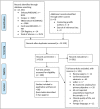Understanding economic evidence for the prevention and treatment of atopic eczema
- PMID: 30693473
- PMCID: PMC6790711
- DOI: 10.1111/bjd.17696
Understanding economic evidence for the prevention and treatment of atopic eczema
Abstract
Background: Atopic eczema is an inflammatory skin condition, with a similar impact on health-related quality of life as other chronic diseases. Increasing pressures on resources within the National Health Service increase the importance of having good economic evidence to inform their allocation.
Objectives: To educate dermatologists about economic methods with reference to currently available economic evidence on eczema.
Methods: The role of different types of economic evidence is illustrated by evidence found in a systematic literature search conducted across 12 online databases up to 22 May 2017. Primary empirical studies either reporting the results of a cost-of-illness study or evaluating the cost, utility or full economic evaluation of interventions for preventing or treating eczema were included. Two reviewers independently assessed studies for eligibility and performed data abstraction, with disagreements resolved by a third reviewer. Evidence tables of results were produced for narrative discussion. The reporting quality of economic evaluations was assessed.
Results: Seventy-eight studies (described in 80 papers) were deemed eligible. Thirty-three (42%) were judged to be economic evaluations, 12 (15%) cost analyses, six (8%) utility analyses, 26 (33%) cost-of-illness studies and one a feasibility study (1%). The calcineurin inhibitors tacrolimus and pimecrolimus, as well as barrier creams, had the most economic evidence available. Partially hydrolysed infant formula was the most commonly evaluated prevention.
Conclusions: The current level of economic evidence for interventions aimed at preventing and treating eczema is limited compared with that available for clinical outcomes, suggesting that greater collaboration between clinicians and economists might be beneficial.
© 2019 The Authors. British Journal of Dermatology published by John Wiley & Sons Ltd on behalf of British Association of Dermatologists.
Figures
References
-
- NHS England . Conditions for which over the counter items should not routinely be prescribed in primary care: a consultation on guidance for CCGs. Available at: https://www.england.nhs.uk/medicines/conditions-for-which-over-the-count... (last accessed 12 March 2019).
-
- Paller AS, Mcalister RO, Doyle JJ et al Perceptions of physicians and pediatric patients about atopic dermatitis, its impact, and its treatment. Clin Pediatr 2002; 41:323–32. - PubMed
-
- Lewis‐Jones S. Quality of life and childhood atopic dermatitis: the misery of living with childhood eczema. Int J Clin Pract 2006; 60:984–92. - PubMed


